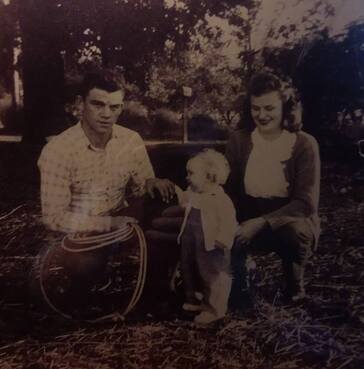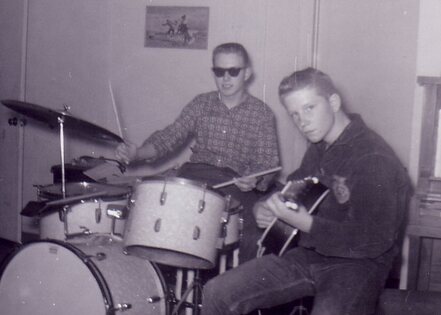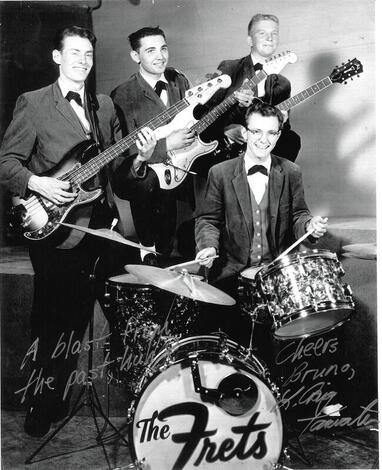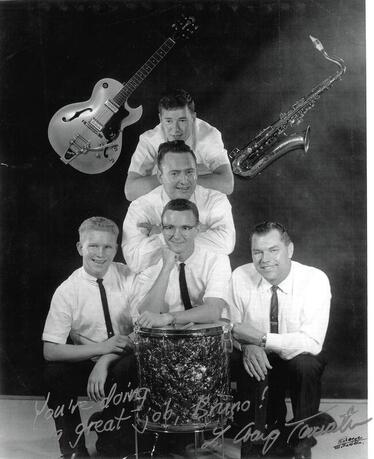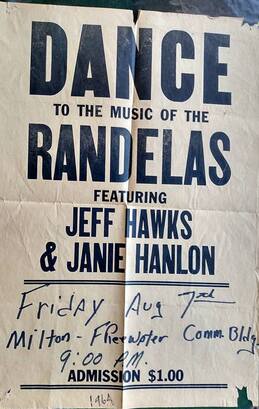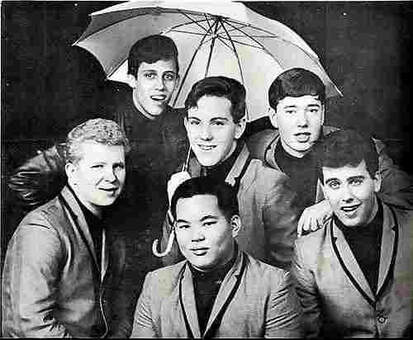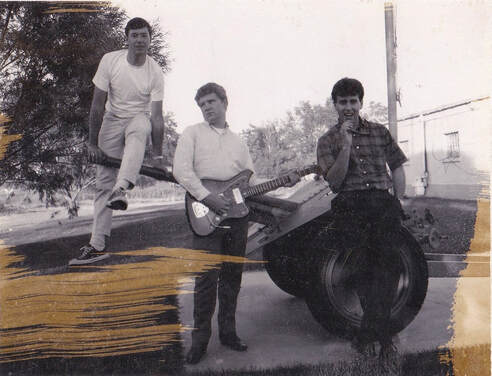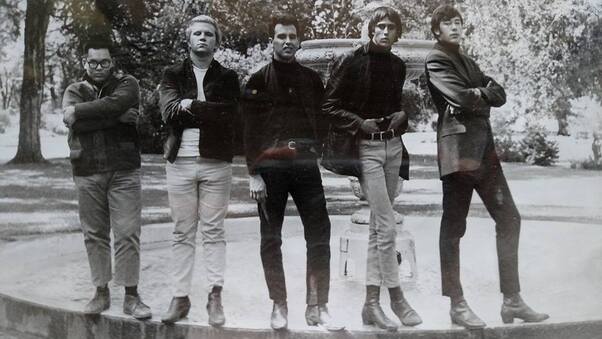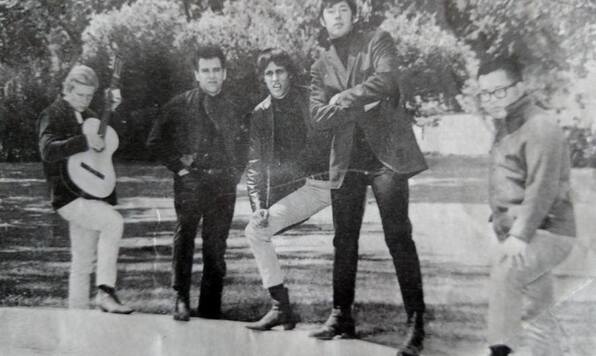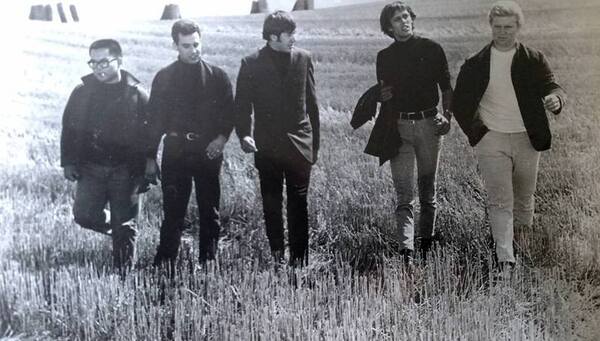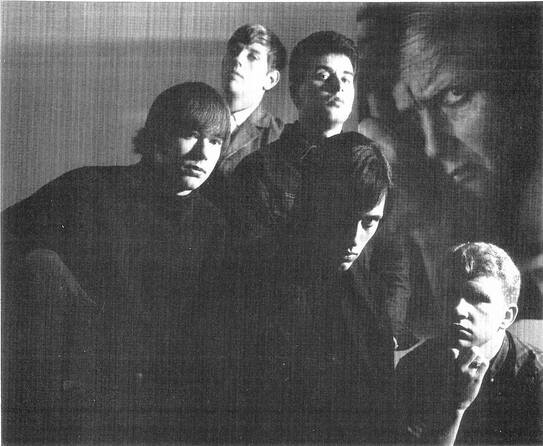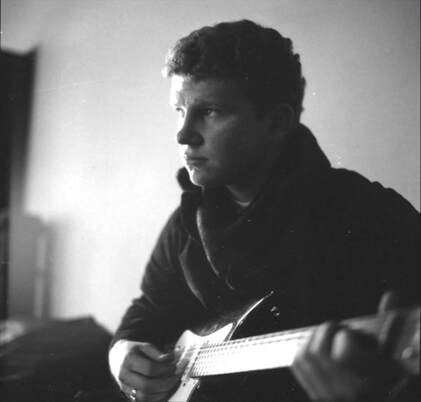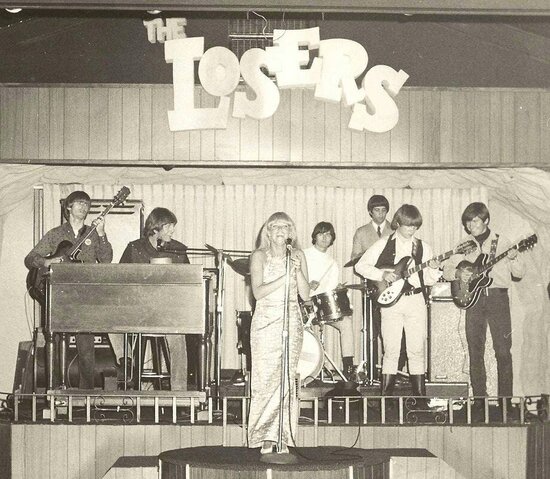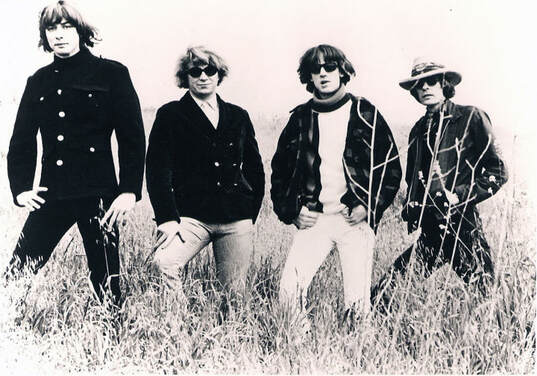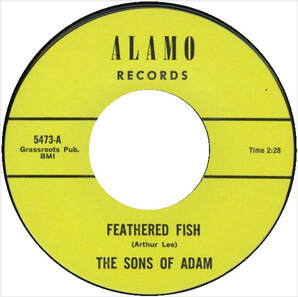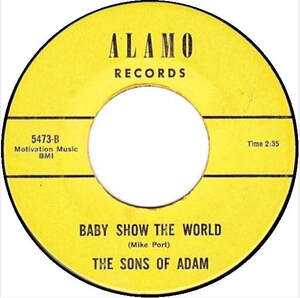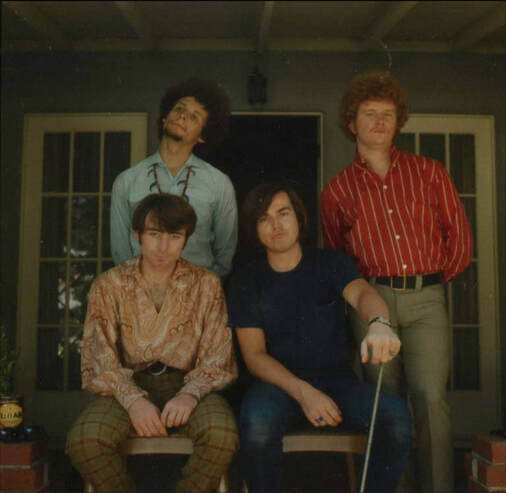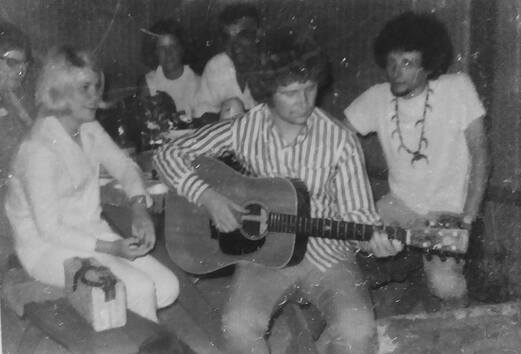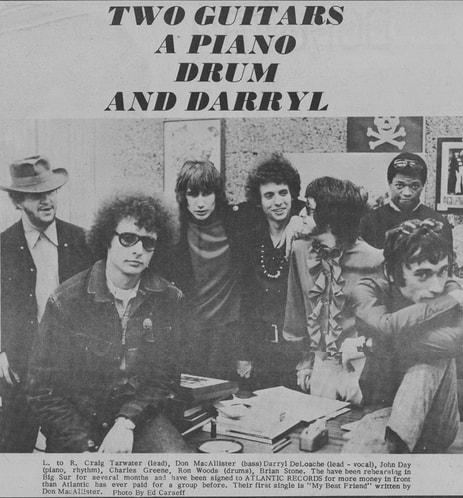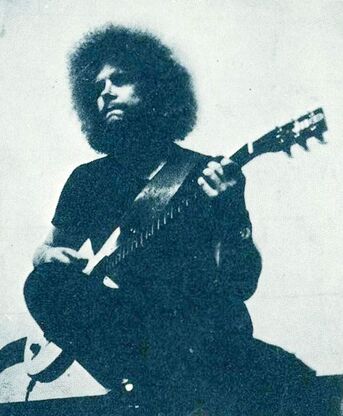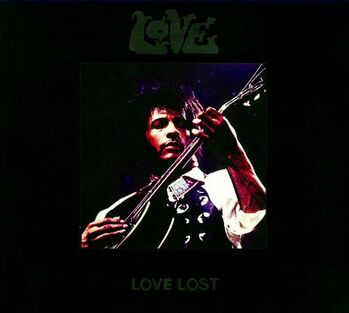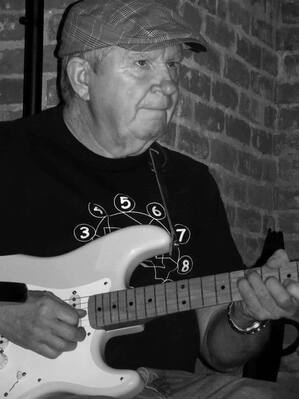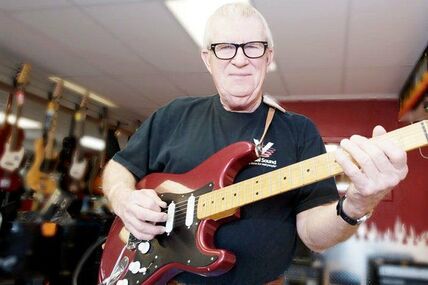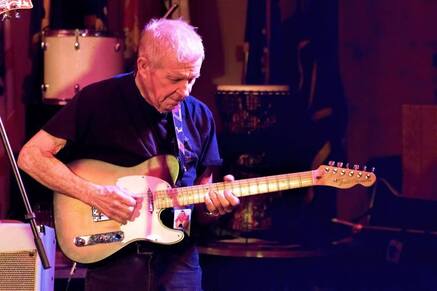If you enjoy what I have put together please consider donating any amount to support and help me to keep this valuable research going. Thanks!!
FAST AS LIGHTNING
by
Bruno Ceriotti
"Let me start off by saying that, besides being a great human being, he is one of the best guitar players I’ve ever heard. Technique was never a problem for him. If he wanted to learn something new, he just figured out what they were playing, and then he played it. You wanted to kick him for making it look so easy.” This is what Jac Ttanna of the Sons of Adam told me about his former bandmate Craig Tarwater. “He was a great guy and a technically gifted, super-talented guitarist,” added another former Sons’ bandmate, Michael Stuart-Ware. “As fast as lightning, he was.” Unfortunately, however, Craig’s master lead guitar work went virtually unnoticed outside his peers, because he never released a record under his own name, he never played on a hit song, and he was never a member of a popular rock band. That’s why he’s one of the greatest guitar players you’ve never heard of. The previously untold story of this unsung hero of the electric guitar, begins in Walla Walla, in the southeastern region of Washington. It was in this place, so nice they named it twice, that Leslie Craig Tarwater was born on Tuesday, December 3, 1946. “Leslie was after my paternal grandfather who was an iceman, and a boxer, and a chicken rancher as well as a school bus driver in his later years,” Craig remembered. “Craig, according to my mother, was for the street we lived on when I was born, and Tarwater is the family name, and no telling where that came from as I have Negro cousins, and my grandfather came from California.” He also got a couple of nicknames from his father. “One was ‘Slugger’, and he said it was because I could really bat a ball hard and far,” he told me. “His other was ‘Lucky’ because I have been all my life!” Craig was the first child of Curtis Dale Tarwater and Helen Velera. “I was raised in a loving and caring enviroment by two people who were the definition of ‘40s and ‘50s Americana,” he recalled. “They got a new car when they needed one, not when they wanted one, and we got our first television in 1954, grew up with the Ed Sullivan Show, Mitch Miller, Hit Parade, and all the early sitcoms. My father was a very talented horseshoer, and a rodeo cowboy, later only on weekends. My mother was a homemaker and a very good cook who, according to my father, could not boil water when they first got married. My mother passed on in mid ‘94, and my father in early ‘00,” he adds. “Many vibrant memories remain. I owe much more than my existence to them, more like all of my early influences that assisted in forming my character. My father was the first person I saw play a guitar, and he took me to some of his rodeos where I saw many more pickers, and I was hooked for life!”
"Let me start off by saying that, besides being a great human being, he is one of the best guitar players I’ve ever heard. Technique was never a problem for him. If he wanted to learn something new, he just figured out what they were playing, and then he played it. You wanted to kick him for making it look so easy.” This is what Jac Ttanna of the Sons of Adam told me about his former bandmate Craig Tarwater. “He was a great guy and a technically gifted, super-talented guitarist,” added another former Sons’ bandmate, Michael Stuart-Ware. “As fast as lightning, he was.” Unfortunately, however, Craig’s master lead guitar work went virtually unnoticed outside his peers, because he never released a record under his own name, he never played on a hit song, and he was never a member of a popular rock band. That’s why he’s one of the greatest guitar players you’ve never heard of. The previously untold story of this unsung hero of the electric guitar, begins in Walla Walla, in the southeastern region of Washington. It was in this place, so nice they named it twice, that Leslie Craig Tarwater was born on Tuesday, December 3, 1946. “Leslie was after my paternal grandfather who was an iceman, and a boxer, and a chicken rancher as well as a school bus driver in his later years,” Craig remembered. “Craig, according to my mother, was for the street we lived on when I was born, and Tarwater is the family name, and no telling where that came from as I have Negro cousins, and my grandfather came from California.” He also got a couple of nicknames from his father. “One was ‘Slugger’, and he said it was because I could really bat a ball hard and far,” he told me. “His other was ‘Lucky’ because I have been all my life!” Craig was the first child of Curtis Dale Tarwater and Helen Velera. “I was raised in a loving and caring enviroment by two people who were the definition of ‘40s and ‘50s Americana,” he recalled. “They got a new car when they needed one, not when they wanted one, and we got our first television in 1954, grew up with the Ed Sullivan Show, Mitch Miller, Hit Parade, and all the early sitcoms. My father was a very talented horseshoer, and a rodeo cowboy, later only on weekends. My mother was a homemaker and a very good cook who, according to my father, could not boil water when they first got married. My mother passed on in mid ‘94, and my father in early ‘00,” he adds. “Many vibrant memories remain. I owe much more than my existence to them, more like all of my early influences that assisted in forming my character. My father was the first person I saw play a guitar, and he took me to some of his rodeos where I saw many more pickers, and I was hooked for life!”
Craig was followed by two sisters, Lorraine Ann and Helen Diane, born in 1949 and 1952 respectively. “Both of my sisters, each three years apart downwards from me, were the normal type of girls in an average family, but also were to become good horsewomen, thanks to my father. Both of my sisters were each to become queens of our local yearly country fair in their senior high school years. The youngest is still competing on horses, while the one in the middle is a realtor in another city.” As Craig recalled above, his father was the first person he saw play a guitar when he was a baby, and since then he fell in love with that instrument, and started playing it after he’d just turned seven, in December 1953. Initially, though, his father tried to persuade Craig to follow in his footsteps and shoe horses. “He tried on me, but did not pursue it, as my guitar interest was too strong, although I was good with horses.” Exactly seven year later, in December 1960, Craig was good enough on guitar that he decided to put together an instrumental rock ‘n’ roll band with Patrick E Craig on piano and trombone, his brother Bill Craig on trumpet, Spike Friedman on trumpet, Paul Trousdale on alto sax, Ken Wilson on tenor sax, Brian Conrad on drums, and Mike Beck on bass and trombone. “We called it Pontius Pilate & the 5 Happy Nail Drivers, but only to ourselves!” he laughed. “I remember it as Pontius Pilate & the Nail Drivin Five,” Pat Craig points out, “but it was just a very bad joke name that Craig made up. We couldn’t use it in public of course, so we called ourselves the Intellectuals when we played.” "Craig was a fun guy to play with," recalls Bill Craig. "His stage persona was so serious, we organized 'smile breaks' so he could look up from his playing and smile just so the audience would know he could."
After a year and a half, the Intellectuals disbanded. Later, Pat Craig would form West Coast Natural Gas, Brian Conrad joined Magic Fern, and Paul Trousdale went on to Brave New World. Meanwhile, around May of 1962, Tarwater formed a new instrumental band. Beside Craig on lead guitar, the band also included Steve Allen on rhythm guitar, Arlan Gibb on bass, and Don McCoy on drums. “My second group was the Frets, and we covered the Ventures very well,” Craig recalled. “It was my first real good group, we played many teen dances and had a fairly big following.”
That same year, the Frets signed a deal with a local label called Uptown Records, and released their first and only single, 'Sunday Drive / Do You Want to Dance.' The A-side was an instrumental composed by Craig, while the B-side was a cover of Bobby Freeman’s 1958 classic, sang by a girl named Janie Hanlon. On July 2, 1963, the Frets opened for Jan & Dean at the Walla Walla’s Natatorium on Wilbur Avenue. “I remember that after the gig we ended up with Jan and Dean at a local late night bar and grill, and continued the party till late into the night,” Steve Allen recalls. It was their biggest gig so far, but also one of their last, because the band disbanded that summer. “Steve joined the Naval Reserves, which at that time had two years active, so he had to go, and that took care of the Frets!” Craig explained. At that point, Craig and drummer Don McCoy put together another instrumental band with Kirk Holmquist on electric piano and Vox organ, Orville Ott on bass (president of the local musicians union and cousin of Paul Revere from the Raiders), and Darrell Ovens on tenor sax, the latter soon replaced by Ken Wilson, formerly of the Intellectuals. The band did not have a name and never played in public, but, after McCoy was replaced on drums by Jack Bond, and Ott was replaced on bass by Terry Martin, they named themselves the Squires and started to play some gigs around the town.
Craig, however, did not always play with the Squires. “Sometimes we would just play as a four-piece with no guitar,” remembers Ken Wilson. “He’s always been a free spirit. He was so good then that we just put up with it.” In 1964, Craig even missed a session where the band recorded five songs, which were never released. In the spring of 1964, the Squires disbanded and Craig, Ken and Kirk subsequently formed a new band with Don McCoy back on drums, and Ron 'Buzz' Overman, formerly of the Gems, on vocals and bass. Originally the five-piece - now led by Ron because he was older, wiser and had just quit the best band in town - did not have a name but, after they added a couple of lead singers, Janie Hanlon, fomerly of the Frets, and a new face in town named Jeff Hawks, they named themselves the Randelas. “Then along came the Randelas,” Craig confirmed, “which was me, Ron, Kirk, Ken, and Don. We then found out of this Air Force guy, Jeff Hawks, and we hired him. He was our frontman.” “I met Ron Overman sometime in 1963 in Portland, Oregon, while he was playing with the Gems,” Jeff Hawks recalls. “Then the Air Force transferred me to a small base in Ron’s home town of Walla Walla, and we hooked up again. I happened to show up on the scene at just the right time. He was putting together a new group with Kirk, Ken, Craig and Don. He was going to feature a chick singer, Janie Hanlon, on a number of songs, and asked if I wanted to be her male counterpart - you know, sing a segment of the gig, like three or four songs to pep up the night. Course I accepted, and we rehearsed a lot for the next few weeks.” After only three weeks of rehearsals, the Randelas were apparently already good enough to head into a recording studio for the first time. “Ron wanted to hit town like stars, so he set up a recording session up in Spokane at I forget whose basement studio,” Hawks recalls. “We went in and cut a bunch of songs. The thing is, it all happened so fast because Craig could learn a song after one listening, and the other guys were real good as well. It was my first time being in a band with instruments, and I just thought that’s the way it happened. I got spoiled real quick in the music industry by playing with guys like Craig, Ron, Kirk, and Ken. Yeah, that band was put together in a flash!” According to Hawks, it was during that first session that the band recorded three songs written by Ron Overman that were released a year later on their first two singles: 'I Don’t Wanna Know / Need I Say More' (Uptown UP 811) and 'One Like Me / I Don’t Wanna Know' (Riverton 103), the latter released in September 1965 and credited to Hawk & the Randelas. On August 7, 1964, “The Randelas Featuring Jeff Hawks & Janie Hanlon,” as they were billed, finally made their public debut at the Milton Freewater Community Building. “Ron Overman was booking the band as he was putting it together,” Hawks recalls. “In other words, book first, then show up with a band. He knew he could do it. So, as soon as possible, we rented some sort of hall in Milton-Freewater, Oregon, just over the border from Walla Walla. We packed the place, and I think Ron gave me $25 or so. That was the first gig for the Randelas, a name Ron thought up on the spot when he had a dance hall booker on the phone, and the guy asked what the name of the band was.”
In November 1964, Janie Hanlon left the Randelas probably to move on to college, followed in January 1965 by Don McCoy who joined the Navy and was replaced by a really good new drummer named Frank Eng. In between, by the way, Craig was, temporarily, fired from the band. “Craig was gone all of December ‘64 and back by the beginning of January ‘65,” Ken Wilson recalls. “Ron Overman kicked him out of the band. He didn’t like his wrinkled performance clothes and he wouldn’t do steps with everybody else. Terry Simerlink was the guitar player who replaced him. He never played a gig with us. We just rehearsed and recorded with him during that time. But after using Terry for a month, Ron knew we had to bring Craig back because he was so talented. The rest of us never wanted to kick him out in the first place.”
With Craig on board again, the Randelas headed into Lynnwood, north of Seattle, in February or March 1965, to record their third single for a local label called Camelot, owned by a Norwegian-born drummer-turned-recording engineer and producer named Jan Kurtis Skugstad, who had set up a studio in his basement the year before. The single, 'Love Is Strange / The Angels Listened In' (Camelot J-106), was released later that year and paired a cover of Mickey & Sylvia on the A-side (with Ron Overman sharing vocal duties with their former member Janie Hanlon), and a cover of the Crests on the B-side. Both tracks were co-produced by Skugstad and Overman. In June 1965, after Craig graduated from Walla Walla High School, he and the Randelas backed up the Drifters for a month, traveling throughout the northwest: Washington, Oregon, Idaho, and Vancouver, Canada. “There were two different Drifters groups at that time, one touring in the West and the other touring in the East,” explains Ken Wilson. It was during that tour that the band changed the name to Hawk & the Randelas. “After checking out the Rolling Stones, I got tired of the featured singer thing, and wanted to front the band, so after I can’t remember how long becoming the lead singer, finally the name was changed to Hawk & the Randelas,” Hawks confirms. “We changed the name during that tour and painting that name on Frank Eng’s bass drum head,” Wilson adds. In August 1965, Wilson left the band to move on to college.
In the fall of '65, Frank Eng also left Hawk and the Randelas, and was replaced on drums by Roger Huycke, formerly of the Wilde Knights.
Last but not least, around January 1966, Ron Overman switched from bass to rhythm guitar, and a new bass player, Rick Dey, also from the Wilde Knights, joined. Sometime later, Hawk and the Randelas went down the Oregon coast into California, around Redwood City, in search of fame and fortune, only to disband in April or May 1966 (Overman and Hawks went on to Don and the Goodtimes). Shortly thereafter, Craig and Rick Dey, plus Rick’s brother Tony Dey on drums, formed an unnamed trio to back an up-and-coming singer named Val Garay. “While in the Bay Area peninsula I met, through Rick, Val Garay, who won a Grammy as producer for ‘Bette Davis Eyes’ by Kim Carnes in 1982,” Craig recalled. “He was an auto mechanic who Rick knew, and his father managed a movie theater in downtown LA. His grandparents lived in south San Francisco; we had some Sunday dinners there, and I lived in their house for a short time. We had a short-lived band, played a few clubs - better-class bars really.” "Craig was simply one of the best guitarists on the planet and never really got discovered on a national level," recalls Val Garay. "But I can tell you in my 50 year career, and I've worked with the best there is, he was definitely one of them… and quite funny as well." As Craig recalled, that band did not last for too long, but after they disbanded Val Garay offered him a place in a new band he had assembled to back up Jackie DeShannon at the Losers North in San Jose on July 1-2, 1966 (and probably on a couple of more dates). “I was fortunate to spend some time with her, and we became good friends,” Craig recalled. “The DeShannon gig was no more than four nights; it was what is traditionally called a pickup gig, wherein the players are picked up in the locale of the gig.” Beside Craig on lead guitar and Val on tambourine, the pickup band also featured Lee Michaels on organ, possibly Bob Newkirk on drums, Jerry Harris on rhythm guitar, and Cal Titus on bass.
It was while he played with Jackie at the Losers North that Craig received “an offer he can’t refuse” from the Sons of Adam, a Los Angeles-based band that was a regular fixture on the Sunset Strip scene at that time, featuring Randy Holden on lead guitar and backup vocals, Joe Kooken on lead vocals and rhythm guitar, Mike Port on bass and backup vocals, and Michael Stuart-Ware on drums. “I did see Craig play with Jackie,” Michael recalls, “and she said nice things about his guitar work onstage during the performance that night. I thought she had a lot of class to do that. I was truly astounded the first time I watched him play Roger McGuinn’s lead guitar part on ‘Eight Miles High,’ without missing a lick. When Mike Port and I first went to talk to him about filling Randy’s spot in the Sons of Adam up in San Jose,” he continues, “we went to the apartment where he was said to be staying, and his roommate says, ‘Yeah, he’s in the back bedroom,’ so we went on down the hall and into the back bedroom, but no Craig. So we went back out to the living room and said, ‘Hey, we don’t see Craig,’ and the guy says, ‘Oh, he must be asleep in the closet.’ So we went on back down the hall and opened the closet door, and, sure enough, there he was laying on a comforter, all curled up, cozy as a bug in a rug.” “Michael and Mike Port came in and decided they need me to replace Randy, who was leaving the Sons,” Craig confirmed. “Good thing, as at the time I was living in apartment closet and the Sons had a ready-made house in Laurel Canyon. Exciting times were then to ensue…” So, after Randy Holden played another three gigs already booked with the band in San Francisco, Craig officially replaced him on August 8. At that point the Sons moved back to LA and “improvised like crazy” every night at their home on Amor Road, near Laurel Canyon Park. “Mostly we rehearsed at whatever club we were playing at the time, but the only few times we rehearsed at Amor Road was when Craig joined the group and we were working him in,” recalls Joe Kooken. “Mostly we just developed new songs from jams we did onstage. We did hook up our amps to a turntable, running one channel to one head and one to the other, place the speakers on the floor facing each other, and then lie down between them and listen to records. Probably the most expensive earphones in history, but boy you could hear every nuance of what everyone was playing. Paul Jones vocals on Manfred Mann’s My Little Red Book album were a big influence for me.” Living across the street from the Sons of Adam's Laurel Canyon house at that time were Doug Hastings and Jon Keliehor, respectively lead guitarist and drummer of the Daily Flash, a rock band from Seattle who had recently moved to LA in search of fame and fortune. "Doug and I make friends with Craig because he was from the Washington state like us," recalls Jon Keliehor. "We never really hung out with them and I never knew their names," points out Michael Stuart-Ware, "but we could hear them running over tunes from time to time and they were indeed excellent musicians… a talented band with a heavy jazz influence." "One day we [Daily Flash] get a last-minute offer to play in Arizona, which we take," added Doug Hastings. "I'd just gotten a Les Paul and don't want to take two guitars, so I ask Craig to watch my L-5 while we're gone. When I return he says his house was burglarized and the guitar stolen - I think he did it. The incident of the disappearance of my L-5 has bothered me ever since. I believed his story for a long time but finally had to accept that he and Don [MacAllister] probably sold it for drugs - a betrayal I couldn't quite accept." "I was surprised to hear Doug Hastings accuse Craig of stealing his guitar and selling it for drugs. Actually, I felt as responsible as Craig for the guitar," points out Joe Kooken. "Doug left it with us (The Sons of Adam) for safe keeping while he went out of town. Then we got an unexpected call to play a gig in Dallas. Craig wasn't even in town when that guitar was stolen, and, at that time he wasn't really into drugs either. All we ever did was smoke grass. The Sons had a very close friend who I found out later was a junkie, and who I always thought took the guitar. We were only gone for a couple of days and he was one of the few people who knew we were out of town. I'm not going to mention his name in case he's innocent. But I guarantee you Craig didn't take that guitar." Well, Craig maybe, or maybe not, stolen Doug's guitar, but he surely stolen his place in the Daily Flash the following year (more on that later). Meanwhile, right after he joined the Sons of Adam, Craig, who was only 19 at that time, bought a Social Security card for 20 bucks from an older guy named John Simmons so he could obtain a California ID to play in the over-21 club circuit. More or less inspired by Craig’s new stage name, Joe Kooken also adopted, although not for the same reason as he was already over 21, the nom de plume of Jac Ttanna, or ‘Joe-Jac’ as Mike Port used to call him. “Jac (then Joe Kooken, pronounced Cogan) was the key man in the Sons, and to this day he is one of my best friends even though I have not seen him for over 40 years! A real peach!” Craig told me. Although the Sons new lineup was very good musically, they weren’t making any money, so when three weeks later, on August 29, Michael Stuart-Ware also received “an offer he can’t refuse” to join one of the most famous bands in town, Love, he accepted without a second thought. The band replaced him with Randy Carlisle, a very young drummer with a lot of potential, previously a member of the Yellow Payges.
It was with this new lineup that, probably in September, the Sons entered the studio for the first and only time, and recorded the single, 'Feathered Fish / Baby, Show The World' (Alamo 5473), which was released in October by Alamo Records, a small label run by a strange character named Tony Alamo. “He took us into this studio, a cheap no-name studio, and he was going to be the producer,” Ttanna recalls, “and this engineer didn’t know anything, and he didn’t know anything. We’d be playing one thing, then they’d play the tape back and it would just be this horrible-sounding mess. We were so incredibly discouraged. Fortunately at the end of the session, Lee Michaels came in to see what was going on. He took me aside and said, ‘This sounds like shit. Do you want me to take over?’ I said, ‘Yeah, would you?’ So he went in there and he got what we ended up with on the record, which was way, way better than what we were getting before. It was Lee who came in got everything sounding right after it became apparent that Tony didn’t have a clue.” The A-side was a song written by Arthur Lee, while the B-side was an original written by Mike Port, who also sang lead on it.
Although the single eventually flopped, the Sons of Adam developed a great reputation as a live act so, as 1966 turned into 1967, they continued to play regularly on the Strip in places such as the Whisky à Go Go, Bido Lito’s, and the Hullabaloo, and also in some out of town places such as the Earl Warren Showgrounds in Santa Barbara, the Flying Jib in Redondo Beach, and, in January 1967, in a nightclub in Dallas, Texas, where, Craig remembered, “Casey Kasem had to bail us out to get home. They cheated us on pay right away; not the club owner, but the promoter, Bob Markley of West Coast Pop Art Experimental Band. When we had to make our break, Joe-Jac called Casey Kasem, who wired us money and had our airfare ready at Dallas International Airport’s ticket counter. There was a struggle at the club when we were loading our gear out into the taxis with Bob Markley. He lost, ‘cause Jac threatened his life on the spot, and he was no one to mess with. One of my all-time greatest pals from my past days! The club owner came down to his place and offered us way more money and literally begged us to stay over for another two weeks. As I remember it, we were just homesick and wanted to get out of there.” On June 15, 1967, after a farewell gig at the Hullabaloo opening for Moby Grape, the Sons of Adam disbanded due to lack of success. However, Craig was not too sad for the breakup, because he had already found a new group to play with, none other than the Daily Flash. Aside for the aforementioned Doug Hastings and Jon Keliehor, the band also featured the late Steve Lalor on vocals and rhythm guitar, and the late Don MacAllister on vocals and bass. Craig had in fact joined them when the Sons were still together, in mid-late May, replacing Hastings who had left them disillusioned by their lack of success, but also over differences in musical direction. “I joined the band across the street from the Sons’ house, the Daily Flash,” Craig confirmed. “The Sons ran out of gigs, and Don MacAllister of the Flash thought I was a good blues player - had him fooled!” "[He] was luckily for us waiting in the wings - he was the perfect guitar player," Steve Lalor recalls about Craig. "He was one of the musicians that just stood out. He was comfortable with himself and his guitar playing, plus I liked him a lot as a guy." The new lineup of the Daily Flash soon headed into Gold Star Studios in Hollywood to record a couple of new songs penned by Steve Lalor: 'Again and Again', who remained unissued, and 'Barbara Flowers' who later surfaced on the band's compilation album, 'I Flash Daily', released by Psycho Records in 1984. Then, they moved up north to San Francisco to play a weekend gig at Family Dog's Avalon Ballroom on June 1-2. Right after these gigs, however, when the band returned to LA, Jon Keliehor was fired because he wanted to take a weekend to learn transcendental meditation, which apparently happened to clash with a semi-important, last minute scheduled performance in Las Vegas (a gig that, according to Craig, didn’t end up happening anyway). Anyway, although no longer bandmates, Craig and Jon stayed in touch over the years, and the guitarist even crashed into Jon's house at 8514 Walnut Drive, in the seclusion of Laurel Canyon, from time to time when the drummer was out of town for a gig. Meanwhile, the Daily Flash hired a new drummer named Tony Dey, who had played with Craig in Val Garay's band, and continued to play around the country with gigs in Portland, Vancouver, Denver, San Francisco, Los Angeles, and in their hometown, where one of their show at the Eagles Auditorium on October 6, was captured by engineer Rick Chinn. Among the songs performed and recorded that day, at least a 13-minute epic version of Herbie Hancock’s jazz instrumental “Cantaloupe Island” later surfaced on the band’s compilation album, 'I Flash Daily'.
The abovementioned Gold Star Studios were also the place where Craig was involved into another recording session in late June 1967. Credited on the back cover with his old nom de plume of John Simmons, he played as guest on the self-titled debut album of an all-girl vocal trio called the Cake, which was released in October for Decca Records. Despite, just like the Sons of Adam before, they developing a great reputation as a live act, the Daily Flash failed to reach the success (their only two singles flopped), so in early November 1967 they disbanded - or, more accurately, split into two factions. Steve Lalor and Tony Dey reformed the band with their old guitarist Doug Hastings and Tony’s brother Rick Dey on bass to fulfill some live commitments, while Craig and Don MacAllister relocated to Big Sur, and formed a new band at the dawn of the new year. Originally called Nirvana, the band also featured Ron Woods on drums, formerly of the Dynamics, John Day on keyboards, formerly of Merrell & the Exiles (“a very nice fellow!” Craig recalls), and former Iron Butterfly frontman Darryl DeLoach on vocals and tambourine. Sometime later, the band moved to LA where they signed a management contract with Charles Greene and Brian Stone, “the two guys who in a hijacked office they never had a lease or rent on, put Sonny and Cher on the map!” Craig recalled. Greene and Stone came up with a new name for the band: Two Guitars, Piano, Drum & Darryl (“Charlie named the band, and he mostly thought of anything with frets as a guitar,” Craig explained. “There was only one guitar, myself, and Don MacAllister was the bassist”), and then closed a pretty good deal with Atlantic Records. “I don’t know if we ever did any gigs, but Don MacAllister played his tune ‘Suzanne’ over an intercom speaker standing on a short stool to Ahmet Ertegun of Atlantic Records,” Craig recalls. “Greene and Stone obtained $25,000 front money against royalties - somewhat common in those days - and took most of it to catch up on their severely behind bills. The members got $1,000 each, I pitched a sob story about my mother-in-law, and received $5,000, whereupon I cashed my check across the street and opened an account at the Crocker-Citizens National Bank, later to take a $600-something check in to be cashed and the teller counted out $6000-something, and knowing she would suffer I informed her to do it over again. Boy, was she glad!” The band’s debut single, 'He’s My Best Friend / Spaceman’s Blues' (Atlantic 45- 2522), was released in June 1968. Both songs were original numbers written by MacAllister.
A second single, 'Suzanne / Brown Eyed Handsome Man,' which coupled another MacAllister original composition with a Chuck Berry cover, exists only as an acetate. The band are also rumored to have provided the soundtrack to the cult B-movie Pit Stop, which was released in 1969. Actually the music was credited to the Daily Flash, but because they had already disbanded by then, some people, including Steve Lalor, have suggested that it was Craig, Don and the other guys who played on it. Craig had no clear recollection of the movie or its soundtrack. In the summer of 1968, after their single sold poorly, Two Guitars, Piano, Drum & Darryl disbanded. Craig spend the second half of the year doing demo sessions with Lowell George, then rehearsed for nearly two weeks with Eddie James & the Pacific Ocean. “I didn’t have strong feelings about it, but Eddie was OK as a person,” Craig later recalled. “Around a year past, I found out that Eddie James turned out to be Edward James Olmos, the very fine actor - never knew that until recently!” Craig also played as a guest on Jackie DeShannon’s album, 'Laurel Canyon', which was released on Imperial in November. In 1969, he appeared as guest on another album, Jeff Simmons’ 'Lucille Has Messed My Mind Up', released in September by Frank Zappa’s Straight Records. Craig had first met Jeff in the summer of ‘68 in Seattle when the latter was the bass player of the Easy Chair, and then they reconnected when Jeff moved to LA to start his solo career at the end of that year. In the summer of ‘69, to support the release of his album, Jeff played some local gigs backed up by Craig on guitar and Ron Woods on drums. “At one memorable gig at some dive in El Segundo, a particularly dreary beach town,” recalls roadie Richard Selinkoff, “I took the flak as the middle man between the irate saloonkeeper, who wanted the amps turned down because the neighbors had called the police, and the guitar player, a tough little nut named Craig Tarwater, who went ballistic at the thought of his amps being turned down. I don’t know how I made it through that one, but I did. And the police didn’t bust us, although I imagine that would have given the band some needed publicity. “Jeff was a devotee of the punch line and the zinging adjective,” Selinkoff continues. “He and the other guys in the band had what I assumed were the usual assortment of in-jokes with which band members indulged themselves. I got the feeling most of these in-jokes originated with Jeff. One in particular that I remember was an emphasis on the word ‘rank’. Their invariable assessment of anything assessable, whether a joke or a song or a meal or something that somebody did, was either ‘How Rank!’ or ‘Too Rank.’ They’d invented an imaginary person named Hal Rank, based on the first of the above-mentioned expressions. This of course led to the time-honored pastime of playing with names with other meanings: Dick Hertz, Mel and Collie Baybee, and so forth. The only aspect of life and culture that escaped being classified as Too Rank, apparently, was Pink’s 24-Hour Chili Dog stand on La Brea, which they deemed to be Just Rank Enough. Despite all this camaraderie the band couldn’t survive the lack of commercial response to the album, and broke up.” By early 1970, Craig had moved to Seattle where he backed up, along with his old mate Michael Stuart-Ware on drums and Billy MacPherson on sax, flute and keyboards, local singer-songwriter Danny O’Keefe. “The Danny O’Keefe group had a place where we practiced because we couldn’t practice at his pad,” Stuart-Ware recalls. “It was a big old two-story Addams Family-type house located near downtown Seattle, and around seven or eight people lived there in a sort of commune arrangement. We didn’t give them any money or anything. They were just nice enough to let us practice up there on the second floor for free. There was always this beat up old acoustic six-string sitting over in the corner. It was all messed up and was missing a couple of strings and nobody ever played it, so we all thought it was just a throw-away that nobody wanted that had been left behind by some previous group. So one day between songs, Craig, being the impulsive type, walked over, picked up the six string, placed it down in the middle of the floor, and without a word, jumped about two feet high and came down hard on the six-string, smashing it to smithereens. Then he picked up the pieces, threw them in a closet and closed the door. Not five minutes later, a guy comes up the stairs, sticks his head in, and says, ‘Have you guys seen my acoustic guitar? I thought it was downstairs but I’ve been looking for it everywhere for weeks and no can find, so I’m guessing it must be up here someplace.’ We all looked at each other and said, ‘I haven’t seen it. Have you seen it? No I haven’t seen it. No man, I don’t think it’s up here.’ Then he said, ‘Oh, OK,’ and turned around and left. I guess he found it later. Another day in the same house and on lunch break from practice,” Michael continues, “Craig and I borrowed somebody’s vintage VW van to go get some fast food. After we went through the drive-thru, we just parked in the lot over in front of a big cinder block wall and proceeded to eat our burgers. When we had finished, Craig started up the van, and then, for no apparent whatsoever, and without a word of explanation, he put the VW van in ‘drive’ and ran full-bore the two or three feet headlong right into the cinder block wall, giving us both a slight case of whiplash. You might think I would have said, ‘Hey, Craig, what are you doing?!’ But I didn’t, because you know… I had been through this kind of thing with him before. The unexpected. Then he backed up, put the van in drive again, and ran into the wall again. After he did it a couple more times, we got out to check the damage to the front of the vehicle. So Craig says, ‘Yeah.’ Then we drove back to the house and returned the van, and as far as I know the guy that owned it never mentioned the new dents. Like nobody ever asked me about it or anything. As in, ‘Hey, what happened to my van?’ Those two stories really have no point except to show what a goofy but likable guy Craig Tarwater was. He would do anything for the slightest bit of entertainment,” Michael concludes. At that time Danny O’Keefe had signed a record deal with Cotillion, a subsidiary of Atlantic, and for the first few months he and the band rehearsed all the tunes that were supposed to be on the upcoming album. They had them down well enough to record but they didn’t have a gig. “We had all been living in Danny’s place for months,” Michael recalls. “My visit was long in the tooth. I was finally able to talk Danny into getting a nightclub gig at a nearby dump called, El Roach Tavern, to keep us occupied. It was a tough joint. Fights at the door almost every night. Handwritten sign over the urinal in the men’s room read, ‘You are the person your mother warned you about.’ The El Roach is the only gig I remember us playing. We were there probably close to a month, five or six nights a week.” Meanwhile, for some reason, O’Keefe and the band were taking forever to get rolling on the album sessions. Michael finally got tired of waiting around and after around four months or so he quit and headed back to LA. Craig was still in Seattle with MacPherson waiting for the sessions, but, shortly thereafter, he also got tired and headed back to the City of Angels. Billy, though, stuck around long enough to be the only one who actually played on O’Keefe’s eponymous album which was released in November 1970. Back home, Craig was introduced to Arthur Lee by a mutual friend named David Bialle, “whose girlfriend, Carol Greene, owned Sandwich, a small clothing shop around the corner from the original Guitar Center near Sunset and Sierra Bonita in Hollywood,” Craig recalled. At that time Lee was in search of a new lead guitar player to replace Gary Rowles who had just left Love. So, after a very short audition at Lee’s house in early October 1970, Craig became Love’s new lead guitar player. Once one of the most famous rock bands around, Love were a sort of a “dead band walking” since the time Arthur dismissed all the members of the classic lineup in July 1968. Yes, he reformed the band immediately with new musicians, released other albums, played gigs all over the country and even in England, but it was never the same. They never garnered the widespread acceptance or acclaim of the original group. This may be why Craig’s ten-month tenure as a member of Love has been largely forgotten except by the band’s most diehard fans. Anyway, by then, beside Lee and Tarwater, the band’s lineup included Frank Fayad on bass and Don Poncher on drums, the latter also a new addition, auditioned and hired on the same day of Craig, to replace their previous drummer, George Suranovich. “Don Poncher was the drummer at my audition, and he was phenomenal!” Craig confirms. “I heard some years later that George was equally phenomenal as well.” Right after he joined, Craig also took up residence in the guest house of Arthur ‘s house, a secluded luxury estate at 3580 Avenida Del Sol, up high above Coldwater Canyon Boulevard in Studio City. He lived there until February 1971. “It was during that period that John Keliehor [who had not left the area yet as he was in the group Bodine] introduced me to Genie the Tailor,” Craig remembered, referring to Hollywood fashion designer Jeannie Franklin, “who was a sweet little gal I had one date with - to the Topanga Corral whereupon walking in I heard two blond-haired surfer types that played some of the meanest blues guitar I ever heard. I still wonder to this day who they were! And then she got killed in a car wreck not too long after. She was a really nice young gal, and very pretty too. I guess some part of my past misses her.” (Jack Bruce’s 1969 album Songs for a Tailor was dedicated to Jeannie.) Meanwhile, in November 1970, after a month of rehearsals, the new lineup of Love was ready to tour the country. They played in St Louis, Missouri, and then Dallas, Texas. “We were greeted by the Official Love Fan Club there,” Craig recalled, “and said ‘Hi!’ to Roy Clark [the famous country singer] passing through the airport corridors! He said ‘Hi!’ back to us. Nice man!” Last but not least, on November 19-22, they played at Bill Graham’s Fillmore West in San Francisco. Love’s two sets from their November 21 show, were recorded by someone in the audience and later released on a bootleg titled 'Love with Arthur Lee - Fillmore West 23/11/70.' (The album features two howlers: firstly the recording date listed on the title is incorrect, because Love did not play at the Fillmore on November 23; and, secondly, the photo of the band that was used on the sleeve shows the old Love lineup with Gary Rowles and George Suranovich.) Also, three tracks taken from the band’s second set (“Stand Out,” “Find Somebody,” and “Always See Your Face”) later officially appeared on Arthur Lee & Love’s 4-CD Box Set, 'Coming Thru To You: The Live Recordings (1970-2004),' released in 2015 by Rockbeat Records (although the album’s liner notes wrongly list the old Love lineup with Rowles and Suranovich, instead of Tarwater and Poncher). In December 1970, Love continued their US tour with dates at Bill Graham’s Fillmore East in New York City on the 4th and 5th, at the Boston Tea Party on the 17th through the 19th (a song taken from one of their sets, “Product Of The Times,” was released by High Moon Records in 2012 as a bonus track of the previously unreleased 1973 album, 'Black Beauty'), and at the Milwaukee Civic Arena on the 23rd for “the biggest audience I had ever played for, over 10,000 people,” recalled Craig. “We were opening for Grand Funk Railroad. After we were done, there was this deafening roar and all these lighters held in the air. When we came off stage, someone delivered us a case of beer from the Schlitz Brewing Company of Milwaukee. Then a dealer came through and cocaine was distributed discreetly.” Then they played at the Eastown Theatre in Detroit on December 25-26, at the Toledo Sports Arena on the 27th, and at the Miami Marine Stadium at the end of the month. Back home at the dawn of the new year, Love played some other gigs, including a local one at Valley Music Theatre in Woodlands Hills on January 29, and a couple in Canada at Kinsmen Field House in Edmonton on February 13, and then at PNE Coliseum in Vancouver on February 14, before started rehearsals for a planned extended European tour that should’ve started in April. “For whatever reason it fell through,” recalled Craig. On April 1, Arthur Lee signed a solo recording contract with Columbia/CBS. At that point, Love almost stopped playing live (the only gig I’m aware of was on May 28 at the University of San Diego), and, between May 5 and July 15, recorded their seventh album (the first with Craig) at Columbia Recording Studios on Sunset Boulevard, described by Craig as “a complex huge like an airport!” Fifteen tracks were recorded over 13 sessions, with Arthur as the producer. Ten of these were recorded by Love (including “CFI,” the only song composed by the entire band, Craig included), while five were acoustic demos with just Arthur on vocals and guitar. However, when the record deal between Love and Columbia was canceled in July 1971 so was the release of the album, rumored to have been titled Dear You. Understandably disappointed by the situation, Arthur immediately broke up the band and went into a period of retirement from the music business. “We did these sessions at CBS, but no record deal came out of those,” Craig lamented. “Some of us became demoralized and the band just sort of drifted apart. After that, we just didn’t do anything no more.” Fortunately for Love fans around the world, the recordings from these sessions were finally released in 2009 by Sundazed Music as 'Love Lost'.
Meanwhile, in January 1972, Arthur Lee returned on the scene with a new deal with A&M Records for a solo album. At that point he needed to put together a new band as soon as possible to play some warm-up gigs and start recording. Fortunately, Craig, Don Poncher, and Frank Fayad, are still in touch so Arthur called them back. Now calling themselves Band-Aid, they backed up Arthur on three songs -“Find Somebody,” “Hamburger Breath Stinkfinger,” and “Ol’ Morgue Mouth” - recorded in March at A&M Studios in Hollywood. The sessions for the album, which was released in June as 'Vindicator', continued until early April, but without Craig and Frank, who were in the meantime replaced by Charles Karp and David Hull respectively. “The last time I saw Arthur was [in 1974] when he was recording Reel-To-Real at the Record Plant West in West Hollywood,” recounted Craig. “He invited me to some of the sessions, and when I walked in Buzzy Feiten was playing. I was so embarrassed at my distinct lack of chops in the shadow of his giant ones I almost left, but I stayed anyway. About two years later I was with some guys doing a run up in the hills high above Sunset Boulevard, and at that house Buzz was wandering the halls, he heard me playing on some guitar in the hallway and asked one of the guys to come ask me if I gave lessons - guess I fooled him, too.” Sometime later that same year, Craig reconnected with his old mate Jeff Hawks, who had recently played a couple of clubs around LA with a short-lived band called Lil’ Bit. After that band broke up, Jeff got some studio time from engineer and producer Wiley C Brooks and invited Craig to play guitar on the session. Jeff also invited Bruce Hauser, who had played bass with him in the Lil’ Bit, and Craig brought along his old mate Ron Woods to play drums. “What I remember is that the studio (I can almost remember the name) was operated by a dude named Wiley Brooks, and the sounds were really good,” Jeff recalls. “Wish I could tell you more about that studio on 6th Street at Vermont Avenue in LA. The only song I remember coming out of the session was ‘Mississippi Dirt Road.’ That song was written by Tarwater, Jeff Simmons, and me.” The session, however, wasn’t recorded and the four-piece didn’t gel, so Craig and Woods were replaced by Joey Newman and Lenny Fagan respectively, and the new lineup became a bluesy hard-rock band called Stepson, who recorded “Mississippi Dirt Road” a couple of years later. Also in 1972, Craig was involved in another studio session at Golden State Recorders in San Francisco along with a cast of notable musicians such as Michael Bloomfield, Nick Gravenites, Michael Shrieve, Lee Michaels, Barry Goldberg, John Kahn, Bill Vitt, and Mark Naftalin. The ad-hoc band, who called themselves Mill Valley Bunch, recorded an entire album which was released by Verve in 1973 as 'Casting Pearls.' Afterwards Craig decided to retire indefinitely from the music scene, and find a ‘real’ job to pay the bills. He fixed bikes for a while, and then became a mechanic for a Volkswagen dealership in Pasadena. In 1983, during one of his regular visits to Walla Walla to see his family, he was invited by his old mate Terry Martin to play in a new band called Smokin’ Baby Clams. Beside Craig on lead guitar and Terry on bass and rhythm guitar, the lineup featured another old mate, Ken Wilson, on sax, vocals, and keyboards, and Glenn Ayers on drums. The fourpiece soon headed into Martin’s downstairs studio and recorded a single, 'Leavin’ Here / Put Your Blues Hat On' (HP-100), which was released later that year by the local Hot Poop label. “Leavin’ Here,” a cover of Eddie Holland’s 1963 rhythm ‘n’ blues classic, was also included a year later in a Hot Poop’s compilation album 'Walla Walla Homegrown Volume One' (HP-103). Craig returned to Pasadena shortly afterwards, and resumed work as mechanic, but since then every time he returned home to visit his family he played and recorded with Smokin’ Baby Clams. On January 14, 1989, on his mother’s birthday, Craig returned in Walla Walla definitively and subsequently opened a music shop called Blue Mountain Music Inc. In 1990 he started the Video School of Guitar, after seeing that most of the instructional guitar videos on the market were over the heads of most people seeking instruction. So, with an extremely sound approach to guitar instruction (partly based on a 25 student weekly load), he developed the first series (today the current series includes over 20 videos). In 2012, while he was giving guitar and bass guitar lessons for all ages and all style at Blazing Guitars, Walla Walla’s premier guitar retailer, he was invited by his old mate Terry Martin to play with him on Jimmy Lloyd Rea & the Switchmasters’ double CD, 'American Boogie Man', which was released that year by the local Blues Hat label (Craig played lead guitar on seven songs). This was the last release on which Craig appeared. He continued to record in Terry Martin’s studio from time to time, and also sat in with different local bands, but never really stuck with one band, mostly because he had been in declining health for a long time due to cancer and heart trouble. On Thursday, January 11, 2018, Craig passed peacefully in a hospice in Walla Walla. As fast as lightning you were, I believe you left us even faster, my friend. R.I.P. Craig.

